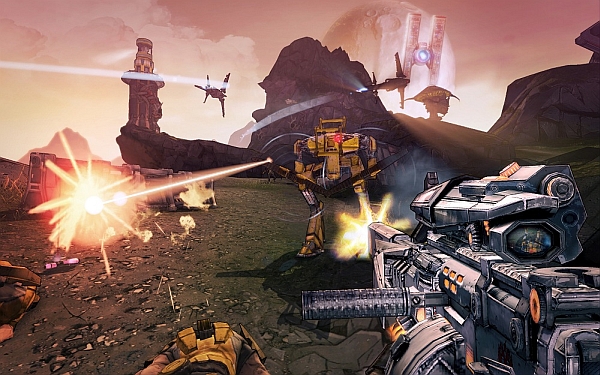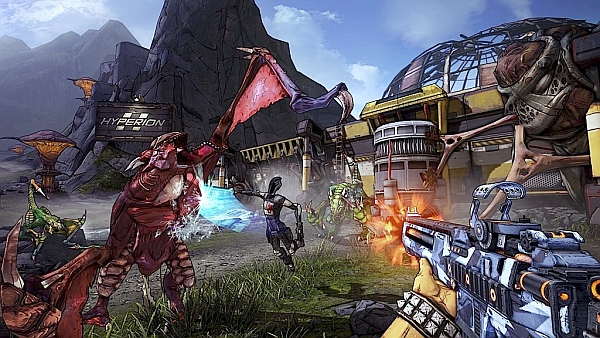
When Borderlands came out in 2009, it blended together the perfect mix of role-playing elements with first-person shooter fare. Affectionately referred to as an FPSRPG, the game’s Diablo-style loot system had players upgrading their guns and shields while working their way up levels and through skill trees. Each of the four characters – Brick the Berserker, Lilith the Siren, Mordecai the Hunter, and Roland the Soldier – were enjoyable in their own way, adding some flavor to the somewhat utilitarian story. Gearbox Studios bragged that Borderlands 2 was going to take everything about the first game and made it bigger – bigger characters, deeper story, better loot. Do these ambitious changes work in the sequel?
Platforms: PC, PS3 (Version Played), Xbox 360
Publisher: 2K Games
Developer: Gearbox Software
Genre: First Person Loot Party
Release Date: September 18, 2012
ESRB Rating: Mature
The answer is that the changes aren’t really as ambitious as they sound. Sure, Gearbox knocked another one out of the park here, but they didn’t really change as much as I thought they would – and that’s not necessarily a bad thing. One of the only real changes – other than the classes and how the skill trees operate – is that Borderlands 2 has quite a robust story, built on what we already know about Pandora and many of the characters we played as or interacted with from the first game. They’ve taken what’s familiar and successfully turned it into a place both recognizable and new, comfortable and yet still exciting.
The Pandora of Borderlands 2, while it does have many familiar faces, enemies, and locations, has changed significantly since we last saw it. Handsome Jack is in charge now, and this nefarious villain hates Vault Hunters. In fact, he tries to kill the four new characters – Axton the Commando, Maya the Siren, Salvador the Gunzerker, and Zer0 the Assassin – in the first cutscene of the game. Angel, the mysterious disembodied live-action face with a voice, shows up to help you out, and from there, it’s just like old times – story missions, optional missions, and now, additional optional objectives.
As you work your way through missions, fighting enemies old (Skags, Spiderants, Psychos) and new (Bullymongs, Goliaths, Threshers), you build up experience and unlock your inherent skill at level five. I played as Zer0 the Assassin, mainly because I’d played the first game as Lilith – twice – and his special ability felt the most like hers, giving me something familiar to work with. I focused on his melee attack skill tree, building it up to the point that it was actually ludicrous. It was common for me to do over 5,000 points of damage on a back attack, and by the time you get to the bottom of that tree, you can stay in Deception and send out another decoy as long as you keep successfully melee killing enemies. What does that mean? It means you soften up a bunch of enemies with gunfire, go into Deception, and melee kill them one at a time, daisy chaining it across the battlefield, gleefully murdering an entire combat session into oblivion like an anime ninja.
What’s the best part of that scenario? The haiku that inevitably and gracefully pours from Zer0, detailing how pleased he is. Even at the 40-hour mark, I was still hearing new haiku from him. These are the kinds of details that make Borderlands 2 an incredible – and incredibly fun – game.
Along with an improved story and dialog (thank you, Anthony Burch), the story missions – and the minibosses in them – are all very well paced. The bosses themselves are, much like the first game, larger than life and out of control. They’re also much easier to handle if you’re not playing as a lone Assassin, or, better yet, if your friend who is also playing Zer0 doesn’t jump in to try and help you. The game definitely leans towards cooperative play, which is not a bad thing, unless you’re a habitual loner gamer, like I tend to be.

That is, until the Mechromancer DLC came out. My boyfriend jumped at the chance to play as Gaige, and I started a second game as Salvador, the Gunzerker. While my ingrained preference is to disappear when things get hairy and reappear behind enemies, there’s a satisfaction that can only be described as hysterical when one goes into gunzerking mode. Your second gun pops out, and you basically go completely insane, shooting both guns, reloading both guns (how do you reload a gun with no hands???), and, if you’re like me, laughing your head off. The Mechromancer’s skill is a little overpowered – Deathbot is basically just a “kill all the enemies on the screen” button – but the character herself is downright adorable. She and Salvador make a good match.
One major change is the way the challenges are set up. In the first game, you had a huge number of challenges – kill a certain number of enemies, use a certain type of gun so many times, open however many number of chests, etc. Each time you accomplished one of these challenges, you would be rewarded with experience points. In Borderlands 2, they’ve made a slight adjustment. They still have many of these challenges, but instead of getting experience points, you get Badass Points, which go towards your overall Badass Rank. Each Badass Point you accrue can be spent on tiny upgrades: a small increase in melee damage, or a faster shield recharge rate, or more base hit points. These go up in fractional increments, but over time, build up to a hefty amount. (They did completely do away with gun experience levels, though – you don’t get improvements in certain guns from using them more often.)
Overall, how do these changes affect the game? Everything here has really been honed to a fine point, creating an experience that isn’t necessarily better than the first game so much as it is a natural evolution. I want to say that the game has grown up, but evolving is not necessarily maturing so much as it is keeping up with the natural order of things. There is no better or worse here, there is only exactly what you would expect: Gearbox has polished a gem that’s already shiny.
Is that a bad thing? No. The only bad thing about Borderlands 2 is that it just doesn’t take itself seriously at all. “But Nicole,” you might say, “it’s supposed to be a funny game, full of irreverence and sarcasm!” I agree with you, and I love what Borderlands is. But the very first trailer that came out depicted Handsome Jack as sinister and dark, giving me the impression that he was not a humorous character to be taken lightly. You don’t end up taking him lightly, but you can’t take him seriously with all of the ridiculous things he says. The end of the first trailer demands your attention: “Pandora has changed. Are you ready?” Pandora has changed, in that Handsome Jack has taken over. But you’re still doing the same things you’ve been doing all along: searching for the Vault, fighting the corporations/governments/huge jerks that are trying to stop you, killing monsters, quipping off some awesome one-liners. This is a serious situation, but there is nothing serious at all about it.
I will admit that I totally and ironically destroy my entire seriousness argument by confessing that I teabagged Handsome Jack at the end for a good 30 seconds.

I’m lying, actually: there are two other things that I would classify as bad. The first one is the damnable map. Many areas have multiple levels to them, and it’s not always clear where the objective is – is it under you? Above you? But you’re standing right on top of it! I’ve gotten frustrated more than once when I came to what I thought was a path and ended up being a wall that wasn’t on the map. Gearbox really needs to figure out a better way to implement that, because it simply isn’t working. The other main issue I had was the final boss. Remember the final boss from the first game? Remember saying “Gee, I really hope the final boss in the second game isn’t quite so anti-climactic!” Well, that wish fell on deaf ears. But really, with games like these, is the ending ever satisfying enough? The truth is, I never wanted this game to end, and that says something about how good it is.
The very essence of the Borderlands experience is a positive one: a game that gives you an addictive, unforgettable experience, with a story and dialog that make you laugh, bosses that challenge you, NPCs that delight you (and, in the case of Scooter, might worry you a little bit), and a feeling at the end that you didn’t just waste all that time you spent. Hours will fly by as you sit on your couch, promising just one more mission and then realizing it’s five in the morning… on a Tuesday. This is a game that appeals to everyone, from RPG fans to FPS fans and everyone in between. Gearbox isn’t going to get any awards for innovation, but they get my vote for making a sequel I loved just as much as the first game. A word of caution: if you’re going to want to play all the DLC, you might want to wait for the inevitable game of the year edition (unless you are really eager to pay $30-$50 extra). But whatever you do, you should buy this game. Even just for the wub wub.

Review Disclosure: A retail copy of Borderlands 2 was purchased by Warp Zoned for the purposes of this review.







